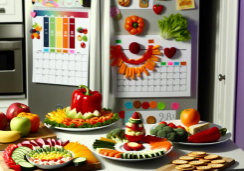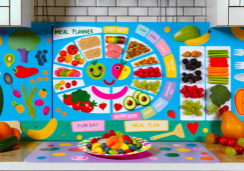30-Day Couples' Meal Plan: A Comparative Guide
Embarking on a 30-day meal plan is akin to setting sail on a culinary voyage with your partner, where the success of your journey hinges on a well-charted map of meals. You're both the captains of this ship, charting a course through the turbulent seas of dietary restrictions, varied tastes, and the quest for nutritious balance.
In this guide, you'll discover not only how to navigate these waters with ease but also how to relish the voyage. You'll learn to assess individual preferences, synchronize your nutritional needs without sacrificing flavor, and implement strategies that make grocery shopping a breeze.
But the adventure doesn't stop there; tackling the kitchen's challenges together can strengthen your bond and infuse your daily routine with new zest. Uncover the secrets to maintaining variety in your meals and find out why this could be the ingredient that keeps your relationship as satisfying as your dinners.
Assessing Dietary Preferences
To ensure mealtime harmony, it's crucial to start by assessing both you and your partner's dietary preferences, pinpointing the foods you both enjoy and the ones to avoid. If your partner is a picky eater, focus on the different dietary staples you both appreciate. A balanced approach is key, mixing proteins, veggies, and carbs to satisfy varied eating habits.
Communicate openly about your relationship with food. If you love cheese but your partner doesn't, find creative ways to incorporate it into your portion alone. Building meals together should be a collaborative effort that respects individual preferences while trying new things.
Customizing recipes can be an enjoyable way to cater to each other's tastes. If you're excited to try new flavors, suggest tweaking a familiar dish with a new ingredient. Meanwhile, avoid using items that either of you strongly dislikes to keep mealtime peaceful.
Experimenting with different cooking methods can also offer a compromise. Grilling, baking, or sautéing can change a food's flavor and texture, making it more appealing. Remember, being flexible and considerate of each other's eating habits can turn shared meals into a joyful, bonding experience.
Balancing Nutrition Needs
Balancing your nutritional needs as a couple hinges on finding dishes that harmonize your carb and vegetable intake while respecting individual dietary requirements and allergies. It's about creating a meal plan that allows both you and your partner to eat nutritiously without feeling restricted. You'll need to shop for groceries that cater to both your tastes and health needs.
Customizing serving sizes is a practical approach to balancing nutrition needs. If one of you needs more protein, simply add a larger portion to their plate. Likewise, you can bulk up on veggies for a partner with a higher fiber need. When prepping meals twice a week, consider dishes where the protein can be easily swapped to accommodate different dietary needs without compromising on taste or nutrition.
Dealing with allergies requires careful grocery selection and meal prep. Always choose ingredients that are safe for both of you, and don't hesitate to use alternative options that sidestep allergens. Remember, the goal is to make meals that nourish both of you together.
Balancing nutrition needs is about effective communication and compromise. By working together, you can ensure that your diet is as much about your health as it's about your partnership.
Planning and Shopping Strategies
When you both sit down to plan your weekly meals, consider each other's food preferences and dietary restrictions to ensure the grocery list supports a diverse and harmonious menu.
Effective meal planning for two isn't just about choosing recipes—it's about creating a shopping list that maximizes the use of fresh produce and other ingredients while respecting your grocery budget.
With a master list featuring a variety of proteins, veggies, and carbs, you can mix and match to make your grocery shopping more efficient. This approach not only saves time at the grocery store but also allows for buffet-style meal prepping, offering flexibility throughout the week.
Don't forget to plan ahead. Discuss and decide on the meals you'll Prep and Cook together, and identify which ingredients can do double duty in multiple dishes. This strategy reduces waste and ensures you're not buying more than you need.
Overcoming Cooking Challenges
Navigating the kitchen as a couple often means facing culinary hurdles together, whether it's reconciling different tastes or managing dietary restrictions. Overcoming cooking challenges starts with crafting meal plans that cater to shared preferences while accommodating individual needs. You don't have to force your partner to eat different foods; instead, focus on cooking healthy dishes that both of you enjoy.
When dietary restrictions come into play, consider prepping tips like cooking two variations of the same meal or experimenting with allergen-free substitutes. This trial and error process allows you to cook healthy and keep meals exciting. Communication is key; openly discuss expectations and concerns, ensuring that mealtime is a compromise that satisfies.
Introduce a new recipe every week to mix things up and avoid the temptation of junk food. Utilize different cooking methods and techniques to change perceptions of disliked ingredients. Remember, overcoming cooking challenges is about balance, nutrition, and enjoyment.
Maintaining Variety and Excitement
While crafting meal plans that suit both partners' tastes and needs, it's equally important to keep culinary experiences fresh and engaging by introducing new cooking techniques and ingredients. Experimenting with different cooking methods, like grilling or slow-cooking, can transform a simple chicken breast into a variety of enticing dishes.
Each week, plan to try at least one new recipe. This could mean opting for a stir-fry instead of your go-to pasta dish, keeping both your palate and skills sharp.
Prep time is the best thing to bond over and learn from each other. Maybe this week, you cook a traditional meal from your partner's culture, or you both try something completely novel, like a meat substitute that's new to both of you. A well-balanced, nutrient-focused menu includes a spectrum of flavors and textures, so don't shy away from bold spices or unexpected combinations.
Consider setting up a buffet-style meal where you both contribute different dishes. This approach not only alleviates the pressure of agreeing on a single meal but also adds an element of surprise and autonomy to your dining experience.
Frequently Asked Questions
How Do You Meal Prep for Two People With Different Goals?
You'll manage meal prep with flexible portions, caloric adjustments, and macronutrient balance. Use shared ingredients, respect flavor preferences, and consider allergies. Cook together, adapt recipes, and choose individualized snacks for a successful meal compromise.
How Much Does Eat This Much App Cost?
The Eat This Much app costs $9.99 monthly, with options for annual ($60) or a lifetime ($189.99) memberships, offering dietary customization, nutrient tracking, and grocery integration suited to your budget and taste preferences.
How Much Does the Intent App Cost?
You'll pay $7.99 monthly for the Intent app, which caters to couples' nutrition, considers dietary preferences, and aids in budgeting meals while accommodating allergies and ensuring portion control with a variety of recipes.
What Is the Best Free Meal Planning App?
You'll find Mealime best for free meal planning, with recipe swapping, nutritional balancing, and allergy considerations. It supports shared preferences, budget planning, and weekly scheduling, ideal for cooking together and dietary compromise.
Conclusion
You've navigated dietary preferences, balanced nutritional needs, and mastered planning with your partner.
Embracing challenges in the kitchen has strengthened your teamwork, and your meals have become a canvas for creativity.
Remember, maintaining variety keeps excitement on your plate.
Continue to communicate and compromise, and you'll find that every shared meal enriches your relationship.
Here's to many more days of healthful, joyful eating together.
Keep savoring each bite and each moment side by side.










